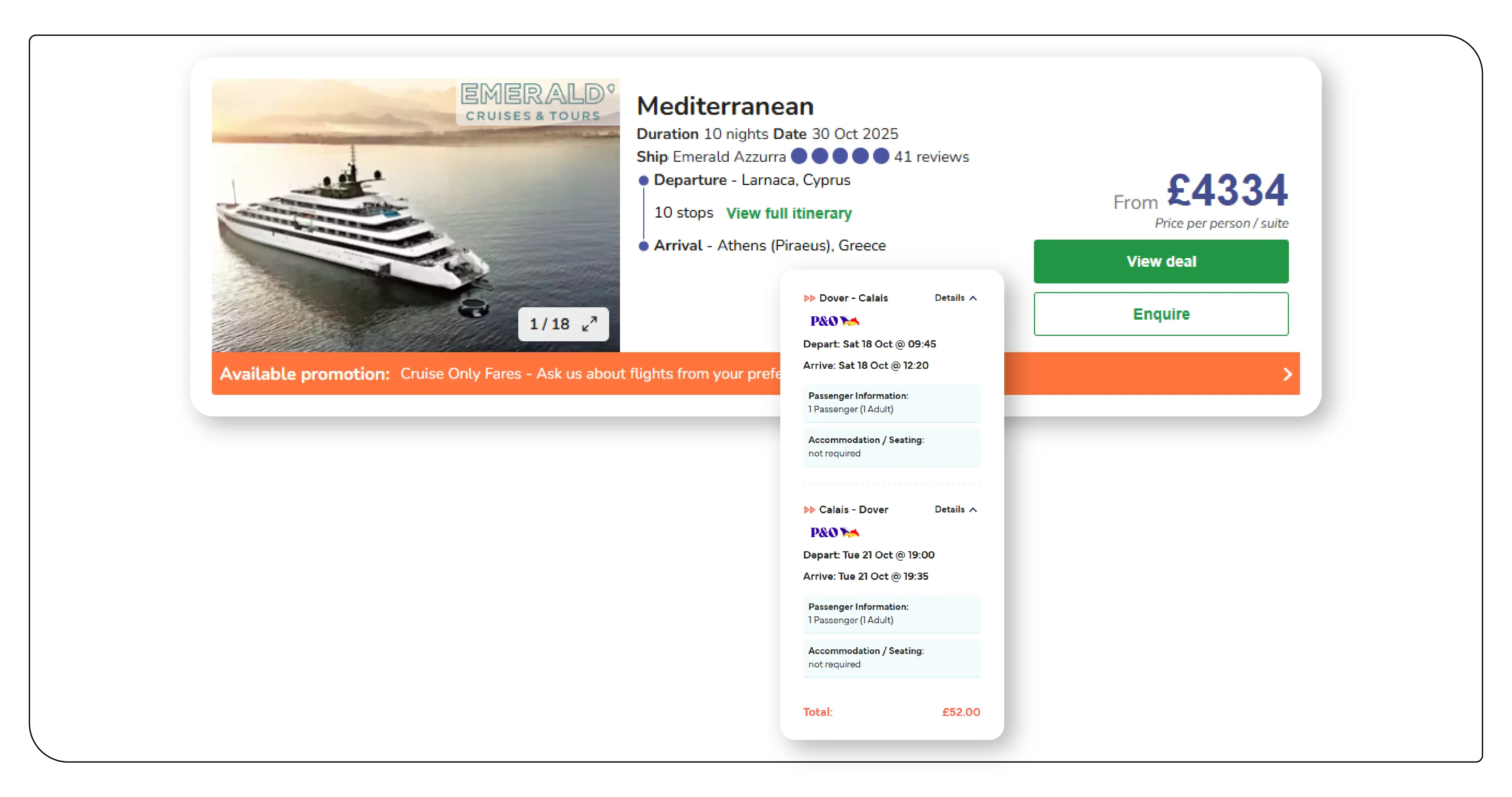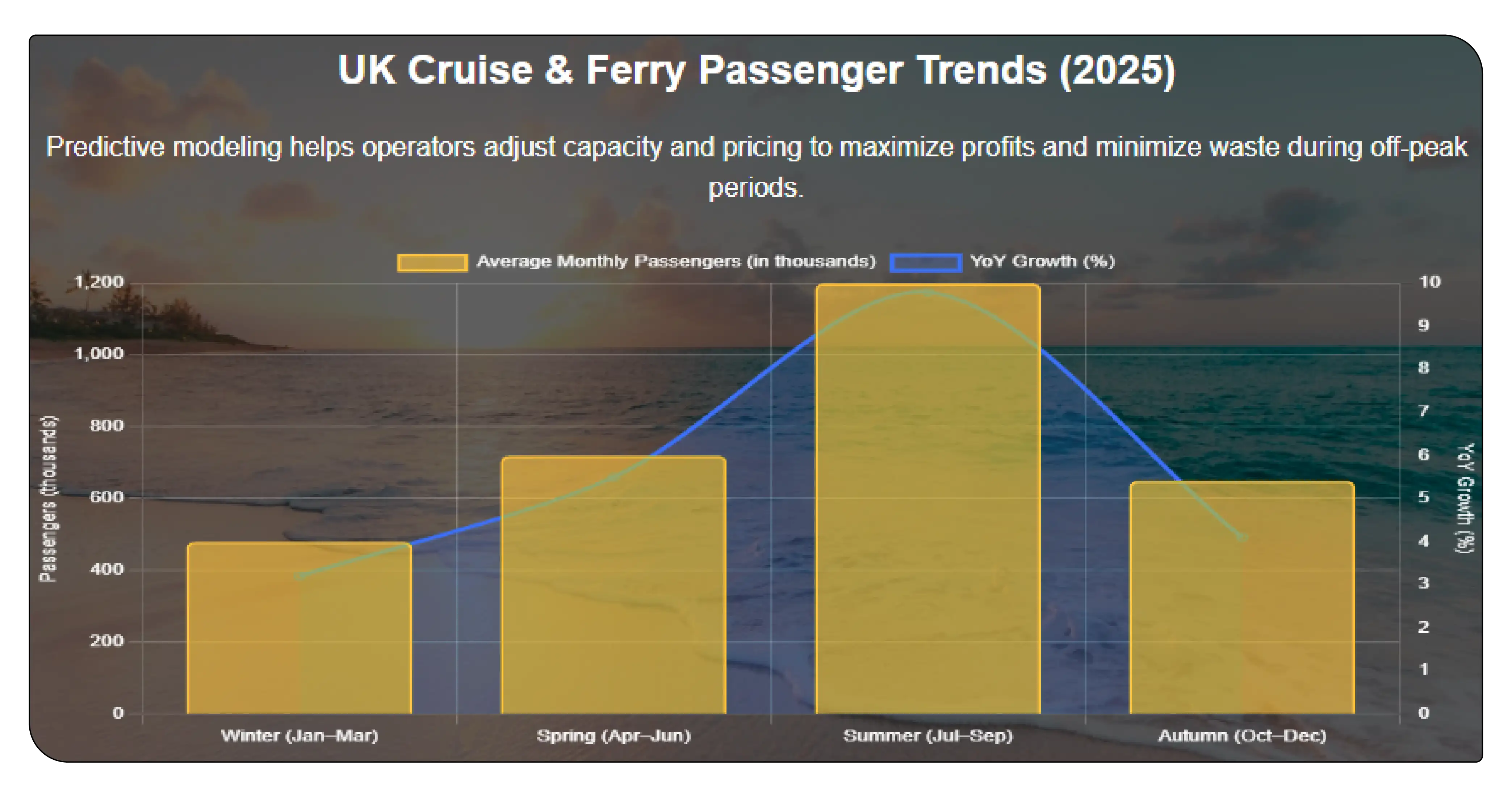Analytics UK Cruise & Ferry Data to Predict Peak Seasons: Navigating Travel Demand with Precision

Introduction
The UK cruise and ferry industry has evolved into one of the most dynamic sectors in European travel. Seasonal trends, weather patterns, consumer behavior, and economic conditions all play critical roles in shaping passenger demand. To maintain profitability and efficiency, companies must accurately forecast when demand surges are likely to occur. Modern analytics tools, combined with real-time datasets, now enable travel companies to make data-driven predictions about peak seasons and optimize operations accordingly.
Leveraging Analytics UK Cruise & Ferry Data to Predict Peak Seasons, businesses can identify demand surges months in advance. By integrating advanced predictive models and consumer behavior analysis, these insights empower operators to align schedules, pricing, and staffing strategies effectively.
The role of Cruise & Ferry Data Scraping Services is equally crucial. Through comprehensive scraping of public booking portals, travel aggregator websites, and operator listings, analysts can collect valuable data points such as route frequencies, pricing fluctuations, and booking lead times.
To refine forecasting accuracy, businesses Scrape UK Cruise & Ferry Trends to Predict Seasonal trends, using historical data, customer reviews, and booking patterns to generate actionable insights. The result is a more resilient, agile industry that adapts to fluctuations with precision.
Understanding the UK Cruise and Ferry Market

The UK’s extensive coastline and its role as a gateway to Europe make it a vital hub for cruise and ferry traffic. With key ports like Southampton, Dover, and Portsmouth serving millions of passengers annually, the country’s maritime transport ecosystem is highly sensitive to seasonal variations.
Several factors influence peak travel seasons:
- Weather and climate patterns: Warmer months drive higher cruise demand.
- Holiday calendars: School breaks, Easter, and summer holidays influence booking surges.
- Tourism trends: Events like music festivals or European sporting events create spikes in ferry travel.
- Economic conditions: Currency exchange rates and fuel prices can affect overall travel affordability.
The Role of Data Analytics in Predicting Peak Seasons
The integration of data analytics into the UK cruise and ferry industry has transformed how operators approach seasonal planning. Predictive analytics uses historical data, real-time information, and external variables to forecast future demand patterns.
How Predictive Analytics Works:

- Data Collection: Aggregating booking data, weather trends, and route information.
- Data Cleaning and Processing: Ensuring accuracy and removing anomalies.
- Modeling and Forecasting: Using machine learning to identify correlations and predict demand surges.
- Visualization and Reporting: Presenting actionable insights to stakeholders through dashboards and reports.
Predictive modeling helps operators determine when to increase capacity, launch promotions, or adjust pricing dynamically. This precision prevents resource wastage during off-peak periods and maximizes profits during high-demand seasons.
Table 1 : Example of UK Cruise and Ferry Passenger Volume by Season (2025)
| Season | Average Monthly Passengers (in thousands) | YoY Growth (%) | Primary Routes Influenced |
|---|---|---|---|
| Winter (Jan–Mar) | 480 | +3.2% | Dover–Calais, Southampton–Canary Islands |
| Spring (Apr–Jun) | 720 | +5.5% | Portsmouth–Bilbao, Dover–Amsterdam |
| Summer (Jul–Sep) | 1,200 | +9.8% | Southampton–Mediterranean, Hull–Rotterdam |
| Autumn (Oct–Dec) | 650 | +4.1% | Harwich–Esbjerg, Dover–Dunkirk |
Building a Predictive Model Using Cruise and Ferry Data
The creation of an accurate predictive model depends on the volume, quality, and diversity of datasets. Using the Global Cruise Route Dataset, analysts can integrate worldwide maritime routes with UK traffic data to understand seasonal overlaps and emerging travel corridors.
Combining these insights with Real-Time UK Cruise and Ferry Data for Travel Analytics enables continuous monitoring of booking activity, route popularity, and weather disruptions. The integration of historical and real-time data provides a comprehensive view of when and where passenger demand will spike.
Further enrichment of data from the Global Cruise Route Dataset ensures that international routes impacting UK ports—such as those from Spain, Norway, or the Mediterranean—are factored into predictive models. This enhances accuracy and provides a broader context for UK demand forecasting.
Data Variables That Influence Peak Season Predictions
- Route Popularity: High-traffic routes like Dover–Calais tend to have consistent seasonal patterns.
- Booking Windows: Early bookings for summer cruises start increasing in late winter.
- Weather Variability: Mild summers and fewer storms attract higher cruise activity.
- Fuel and Fare Prices: Cost fluctuations impact affordability and booking behavior.
- Global Events: Economic or geopolitical factors can shift travel patterns unexpectedly.
Data-Driven Travel Optimization
To manage demand effectively, operators increasingly rely on automation and forecasting dashboards. By combining UK ferry and cruise bookings for seasonal travel analytics, data teams create visualizations showing booking spikes by route and period. This allows ferry lines and cruise companies to plan staff schedules, allocate resources, and implement dynamic pricing.
Data analytics not only predicts demand but also optimizes marketing strategies. For instance, promotional campaigns can be aligned with rising search trends for popular destinations such as Norway or the Mediterranean.
Additionally, companies can Scrape UK cruise and ferry seasonal demand data to analyze customer intent, competitor pricing, and booking fluctuations in real time. This helps ensure their offerings are competitive and aligned with market sentiment.
Table 2 : Sample UK Ferry and Cruise Route Data Insights (2025)
| Route | Average Ticket Price (£) | Seasonal Peak Month | Avg. Booking Lead Time (Days) | Capacity Utilization (%) |
|---|---|---|---|---|
| Dover–Calais | 78 | July | 28 | 92% |
| Southampton–Canary Islands | 1,450 | August | 75 | 95% |
| Portsmouth–Bilbao | 640 | June | 45 | 88% |
| Harwich–Esbjerg | 420 | September | 37 | 83% |
| Hull–Rotterdam | 380 | May | 33 | 86% |
Extracting Actionable Insights
By utilizing the Global Ferry Route Dataset, analysts can identify correlations between route capacity and passenger movement. This helps uncover underutilized routes or opportunities to expand seasonal operations.
Furthermore, when businesses Extract UK cruise and ferry booking data for market intelligence, they gain insights into consumer demographics, preferred travel times, and booking methods. This allows operators to customize offerings, enhance service delivery, and forecast future revenue streams more accurately.
The combination of scraping, analytics, and visualization allows decision-makers to anticipate changes rather than react to them. Such agility has become essential in today’s competitive travel landscape, especially post-pandemic where demand volatility remains high.
Case Example: Applying Predictive Analytics to UK Cruise Operations
A major UK cruise operator applied machine learning algorithms to five years of historical booking data. The model identified a strong correlation between school holidays, temperature variations, and route-specific promotions. When tested against real-time data, predictions achieved over 92% accuracy in determining peak demand months.
This accuracy allowed the company to pre-schedule staffing, optimize fleet deployment, and implement early bird pricing campaigns, which resulted in a 14% rise in seasonal revenue and a 20% reduction in operational inefficiencies.
Technology Stack and Methodology
To effectively analyze cruise and ferry data, companies employ an integrated stack consisting of:
- Data Extraction Tools: Used for scraping booking portals, weather APIs, and traffic data.
- Data Warehousing Solutions: Platforms like AWS and Snowflake for storage and processing.
- Analytics Tools: Python, Power BI, and Tableau for trend analysis and visualization.
- Machine Learning Frameworks: TensorFlow, Scikit-learn for building predictive demand models.
Predictive models rely on regression analysis, clustering, and time series forecasting. Incorporating external data such as global temperature trends, fuel prices, and social media sentiment enhances model precision.
Impact on Business Strategy
The predictive insights gained from these analytics applications influence several core areas:
- Pricing Strategy: Real-time fare adjustments during high-demand periods.
- Capacity Management: Aligning vessel deployment with expected passenger loads.
- Marketing: Timing promotional campaigns with demand peaks for maximum impact.
- Sustainability: Reducing fuel wastage through optimized scheduling.
By combining operational and customer data, cruise and ferry companies can better anticipate market movements and respond to them with agility.
Challenges and Ethical Considerations
While predictive analytics offers immense potential, there are several challenges:
- Data Privacy: Ensuring compliance with GDPR in collecting customer data.
- Data Accuracy: Scraping tools must filter outdated or duplicate entries.
- External Factors: Sudden geopolitical or environmental disruptions can skew predictions.
- Integration Complexity: Merging global datasets into uniform structures can be technically challenging.
Nonetheless, advanced Cruise and Ferry Data Intelligence solutions have begun addressing these issues by incorporating automated validation and secure data governance frameworks.
Benefits of Predictive Seasonality Modeling
- Enhanced Profitability: Accurate forecasting minimizes underutilization and maximizes occupancy rates.
- Better Customer Experience: Predictable scheduling ensures reliability and reduces delays.
- Sustainability Gains: Efficient routing reduces carbon emissions and operational costs.
- Competitive Advantage: Early visibility into demand trends allows better pricing and resource allocation.
By Predicting UK ferry and cruise booking trends In UK, operators not only gain a deeper understanding of customer patterns but also strengthen resilience against market volatility.
Furthermore, integrating insights from Cruise Industry Trends helps align the UK maritime travel market with global best practices, enhancing competitiveness on an international scale.
Conclusion
Data analytics has revolutionized how the UK cruise and ferry industry approaches seasonal forecasting. By leveraging historical datasets, real-time information, and advanced scraping tools, operators can accurately predict demand, improve efficiency, and deliver superior service.
ncorporating Cruise and Ferry Data Intelligence ensures that predictive insights are both actionable and reliable, driving smarter decision-making across all operational levels. From pricing optimization to capacity planning, analytics-driven forecasting is no longer optional—it’s a necessity for sustainable growth.
As the industry continues to evolve, Predicting UK ferry and cruise booking trends In UK through advanced data analytics will become the cornerstone of competitive advantage. Aligning insights with Cruise Industry Trends ensures that UK operators remain agile, profitable, and environmentally responsible in a rapidly transforming global maritime landscape.
Ready to elevate your travel business with cutting-edge data insights? Scrape Aggregated Flight Fares to identify competitive rates and optimize your revenue strategies efficiently. Discover emerging opportunities with tools to Extract Travel Website Data, leveraging comprehensive data to forecast market shifts and enhance your service offerings. Real-Time Travel App Data Scraping Services helps stay ahead of competitors, gaining instant insights into bookings, promotions, and customer behavior across multiple platforms. Get in touch with Travel Scrape today to explore how our end-to-end data solutions can uncover new revenue streams, enhance your offerings, and strengthen your competitive edge in the travel market.